Enhancing Health: SAKG Program for Older Adults & Social Inclusion
VerifiedAdded on 2023/06/03
|18
|3134
|275
Project
AI Summary
This assignment outlines a healthcare promotional plan for implementing the Stephanie Alexander Kitchen Garden (SAKG) program among older adults in Victoria, Australia, who are experiencing social isolation. The project aims to increase social participation among this demographic, thereby improving their overall health-related quality of life. The Socio-ecological model will be the guiding health model, and data will be collected using the photovoice method, specifically the SHOWeD technique. Key stakeholders include older adults (both indigenous and non-indigenous), professional chefs, gardening experts, occupational therapists, community health nurses, and Aboriginal nurses. The intervention involves community-based gardening and cooking classes, with the goal of enhancing community-level performance, decreasing social isolation, and improving health outcomes, including better nutritional intake and increased physical activity. The project's success will be evaluated through questionnaires, nutritional assessments, and the photovoice approach to measure the level of participation and overall impact.
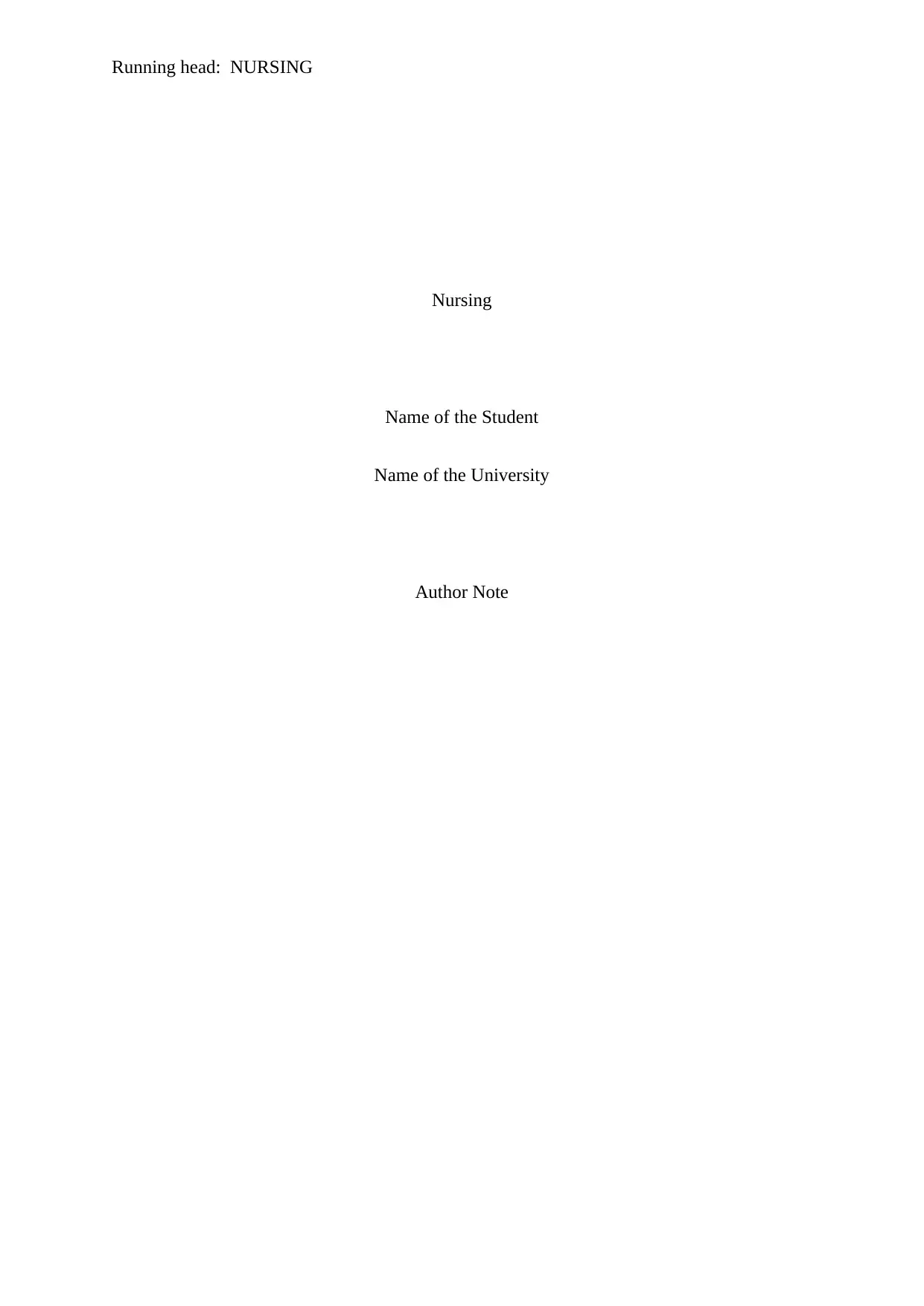
Running head: NURSING
Nursing
Name of the Student
Name of the University
Author Note
Nursing
Name of the Student
Name of the University
Author Note
Paraphrase This Document
Need a fresh take? Get an instant paraphrase of this document with our AI Paraphraser
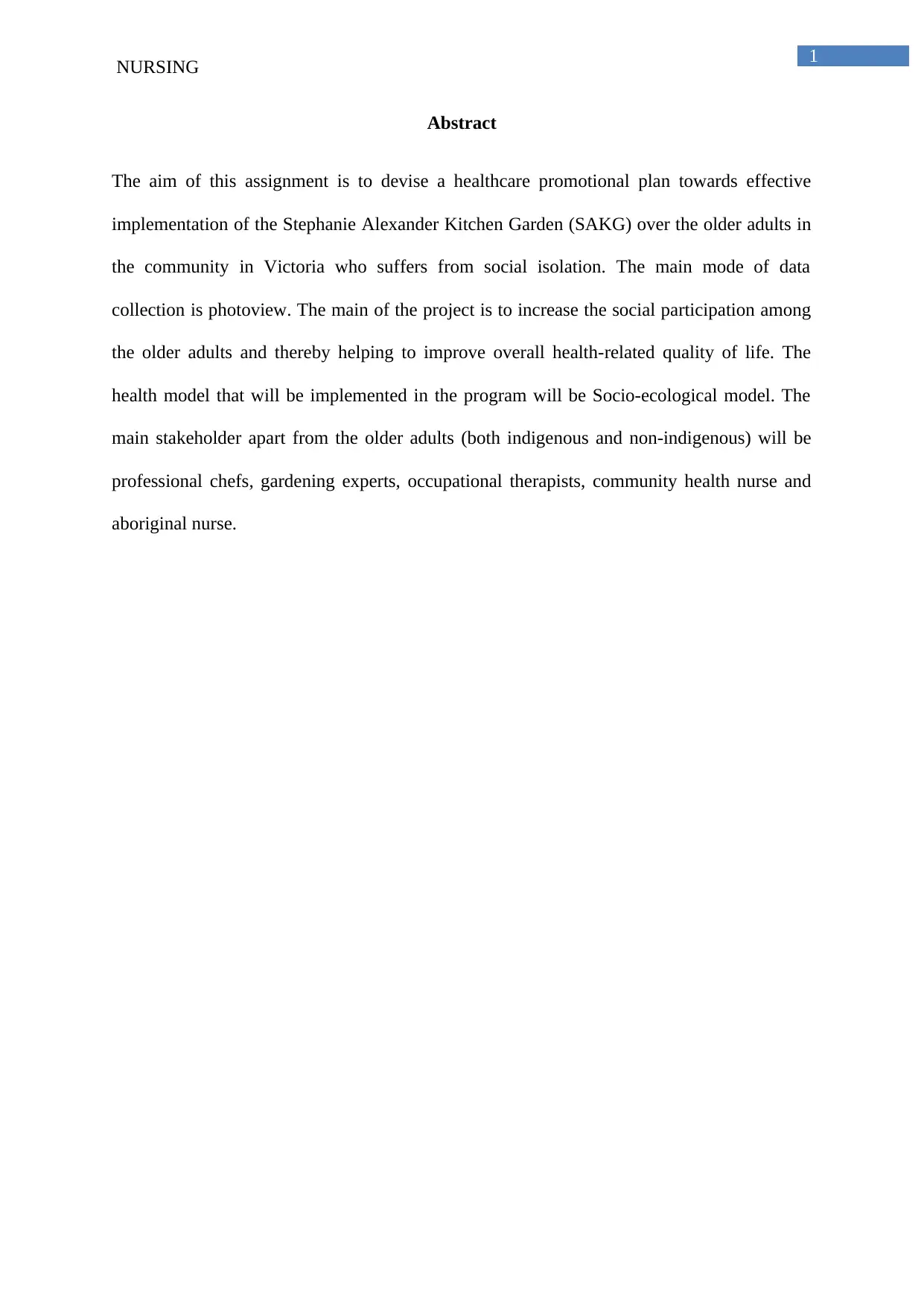
1
NURSING
Abstract
The aim of this assignment is to devise a healthcare promotional plan towards effective
implementation of the Stephanie Alexander Kitchen Garden (SAKG) over the older adults in
the community in Victoria who suffers from social isolation. The main mode of data
collection is photoview. The main of the project is to increase the social participation among
the older adults and thereby helping to improve overall health-related quality of life. The
health model that will be implemented in the program will be Socio-ecological model. The
main stakeholder apart from the older adults (both indigenous and non-indigenous) will be
professional chefs, gardening experts, occupational therapists, community health nurse and
aboriginal nurse.
NURSING
Abstract
The aim of this assignment is to devise a healthcare promotional plan towards effective
implementation of the Stephanie Alexander Kitchen Garden (SAKG) over the older adults in
the community in Victoria who suffers from social isolation. The main mode of data
collection is photoview. The main of the project is to increase the social participation among
the older adults and thereby helping to improve overall health-related quality of life. The
health model that will be implemented in the program will be Socio-ecological model. The
main stakeholder apart from the older adults (both indigenous and non-indigenous) will be
professional chefs, gardening experts, occupational therapists, community health nurse and
aboriginal nurse.
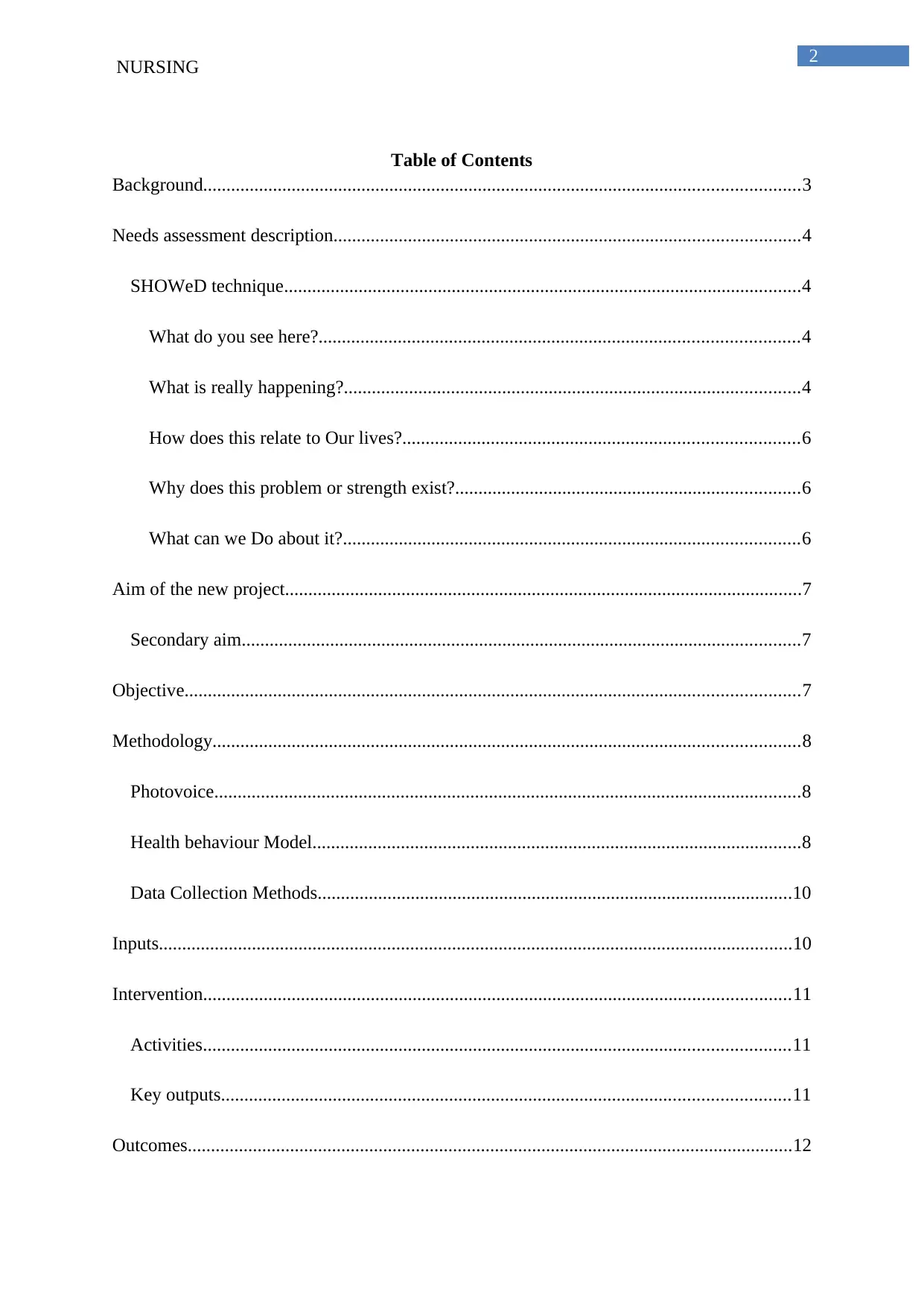
2
NURSING
Table of Contents
Background................................................................................................................................3
Needs assessment description....................................................................................................4
SHOWeD technique...............................................................................................................4
What do you see here?.......................................................................................................4
What is really happening?..................................................................................................4
How does this relate to Our lives?.....................................................................................6
Why does this problem or strength exist?..........................................................................6
What can we Do about it?..................................................................................................6
Aim of the new project...............................................................................................................7
Secondary aim........................................................................................................................7
Objective....................................................................................................................................7
Methodology..............................................................................................................................8
Photovoice..............................................................................................................................8
Health behaviour Model.........................................................................................................8
Data Collection Methods......................................................................................................10
Inputs........................................................................................................................................10
Intervention..............................................................................................................................11
Activities..............................................................................................................................11
Key outputs..........................................................................................................................11
Outcomes..................................................................................................................................12
NURSING
Table of Contents
Background................................................................................................................................3
Needs assessment description....................................................................................................4
SHOWeD technique...............................................................................................................4
What do you see here?.......................................................................................................4
What is really happening?..................................................................................................4
How does this relate to Our lives?.....................................................................................6
Why does this problem or strength exist?..........................................................................6
What can we Do about it?..................................................................................................6
Aim of the new project...............................................................................................................7
Secondary aim........................................................................................................................7
Objective....................................................................................................................................7
Methodology..............................................................................................................................8
Photovoice..............................................................................................................................8
Health behaviour Model.........................................................................................................8
Data Collection Methods......................................................................................................10
Inputs........................................................................................................................................10
Intervention..............................................................................................................................11
Activities..............................................................................................................................11
Key outputs..........................................................................................................................11
Outcomes..................................................................................................................................12
⊘ This is a preview!⊘
Do you want full access?
Subscribe today to unlock all pages.

Trusted by 1+ million students worldwide
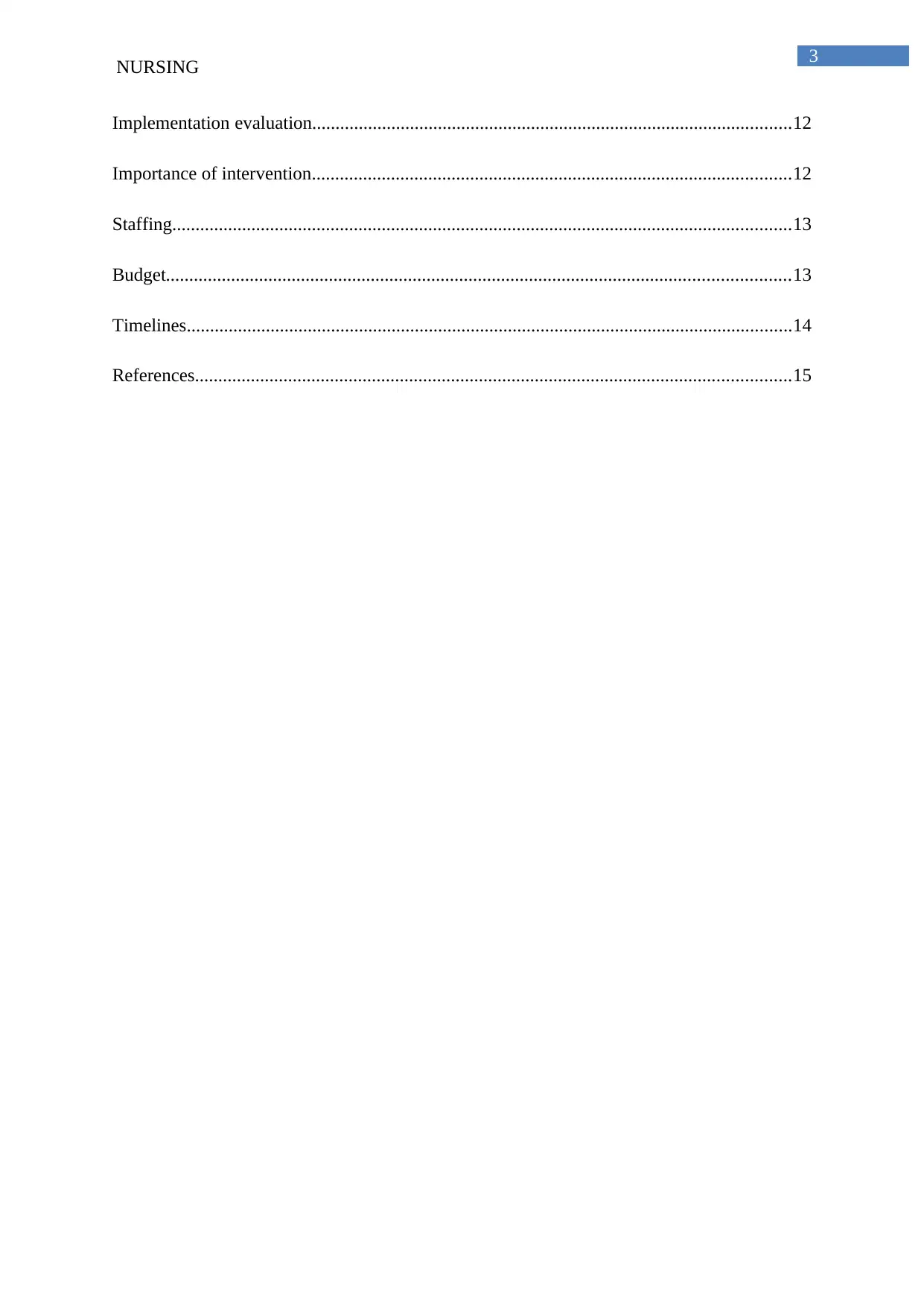
3
NURSING
Implementation evaluation.......................................................................................................12
Importance of intervention.......................................................................................................12
Staffing.....................................................................................................................................13
Budget......................................................................................................................................13
Timelines..................................................................................................................................14
References................................................................................................................................15
NURSING
Implementation evaluation.......................................................................................................12
Importance of intervention.......................................................................................................12
Staffing.....................................................................................................................................13
Budget......................................................................................................................................13
Timelines..................................................................................................................................14
References................................................................................................................................15
Paraphrase This Document
Need a fresh take? Get an instant paraphrase of this document with our AI Paraphraser
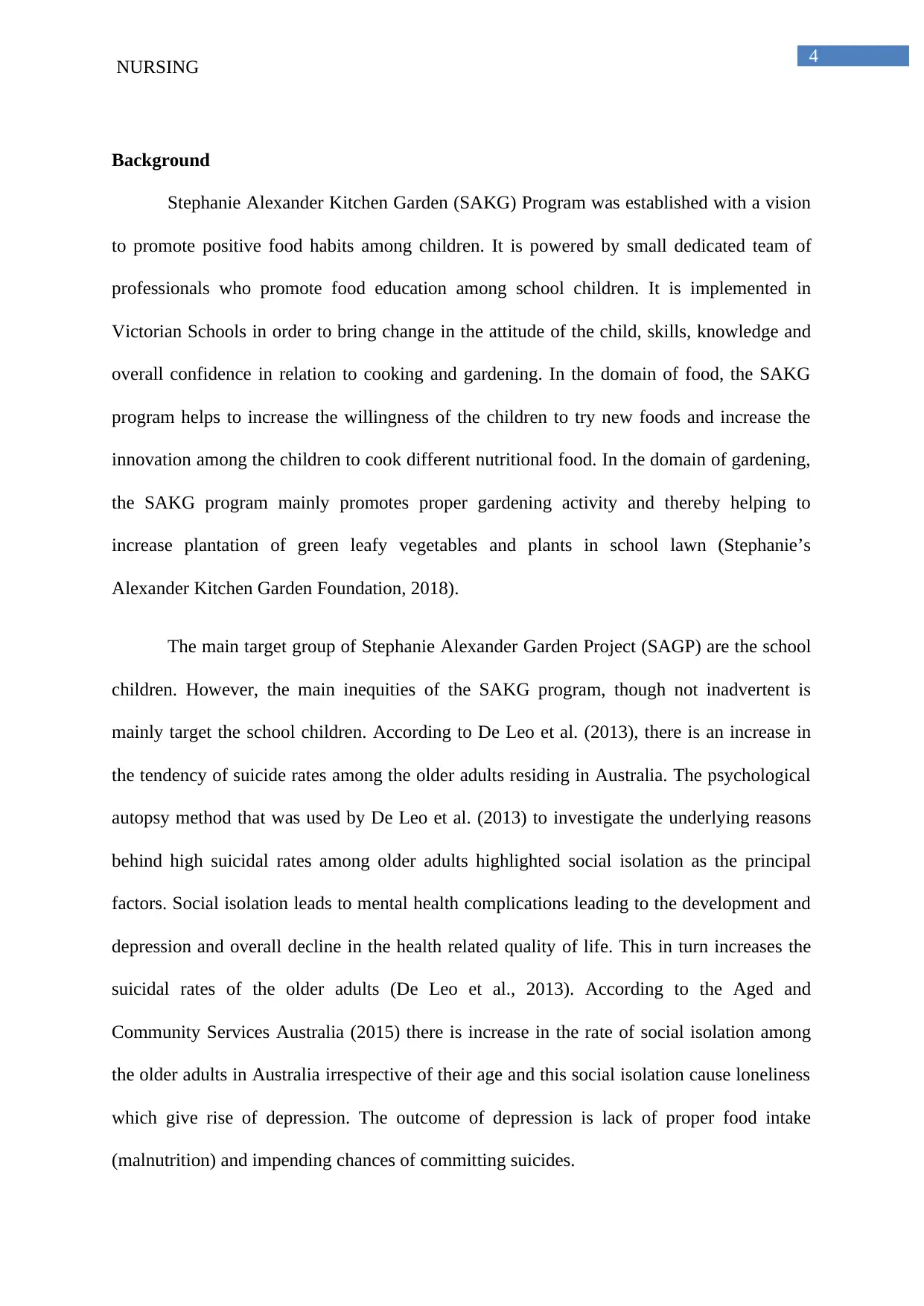
4
NURSING
Background
Stephanie Alexander Kitchen Garden (SAKG) Program was established with a vision
to promote positive food habits among children. It is powered by small dedicated team of
professionals who promote food education among school children. It is implemented in
Victorian Schools in order to bring change in the attitude of the child, skills, knowledge and
overall confidence in relation to cooking and gardening. In the domain of food, the SAKG
program helps to increase the willingness of the children to try new foods and increase the
innovation among the children to cook different nutritional food. In the domain of gardening,
the SAKG program mainly promotes proper gardening activity and thereby helping to
increase plantation of green leafy vegetables and plants in school lawn (Stephanie’s
Alexander Kitchen Garden Foundation, 2018).
The main target group of Stephanie Alexander Garden Project (SAGP) are the school
children. However, the main inequities of the SAKG program, though not inadvertent is
mainly target the school children. According to De Leo et al. (2013), there is an increase in
the tendency of suicide rates among the older adults residing in Australia. The psychological
autopsy method that was used by De Leo et al. (2013) to investigate the underlying reasons
behind high suicidal rates among older adults highlighted social isolation as the principal
factors. Social isolation leads to mental health complications leading to the development and
depression and overall decline in the health related quality of life. This in turn increases the
suicidal rates of the older adults (De Leo et al., 2013). According to the Aged and
Community Services Australia (2015) there is increase in the rate of social isolation among
the older adults in Australia irrespective of their age and this social isolation cause loneliness
which give rise of depression. The outcome of depression is lack of proper food intake
(malnutrition) and impending chances of committing suicides.
NURSING
Background
Stephanie Alexander Kitchen Garden (SAKG) Program was established with a vision
to promote positive food habits among children. It is powered by small dedicated team of
professionals who promote food education among school children. It is implemented in
Victorian Schools in order to bring change in the attitude of the child, skills, knowledge and
overall confidence in relation to cooking and gardening. In the domain of food, the SAKG
program helps to increase the willingness of the children to try new foods and increase the
innovation among the children to cook different nutritional food. In the domain of gardening,
the SAKG program mainly promotes proper gardening activity and thereby helping to
increase plantation of green leafy vegetables and plants in school lawn (Stephanie’s
Alexander Kitchen Garden Foundation, 2018).
The main target group of Stephanie Alexander Garden Project (SAGP) are the school
children. However, the main inequities of the SAKG program, though not inadvertent is
mainly target the school children. According to De Leo et al. (2013), there is an increase in
the tendency of suicide rates among the older adults residing in Australia. The psychological
autopsy method that was used by De Leo et al. (2013) to investigate the underlying reasons
behind high suicidal rates among older adults highlighted social isolation as the principal
factors. Social isolation leads to mental health complications leading to the development and
depression and overall decline in the health related quality of life. This in turn increases the
suicidal rates of the older adults (De Leo et al., 2013). According to the Aged and
Community Services Australia (2015) there is increase in the rate of social isolation among
the older adults in Australia irrespective of their age and this social isolation cause loneliness
which give rise of depression. The outcome of depression is lack of proper food intake
(malnutrition) and impending chances of committing suicides.
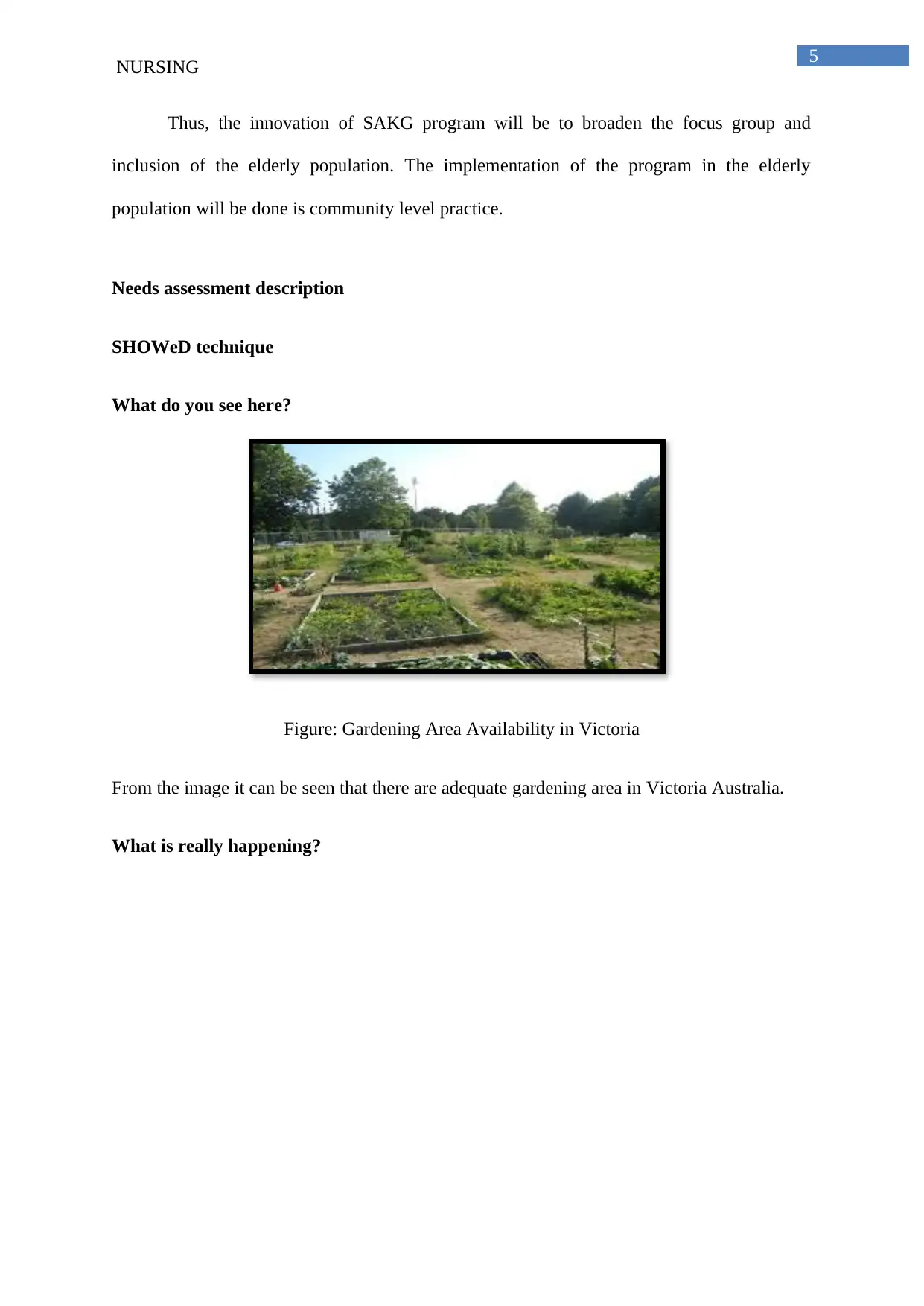
5
NURSING
Thus, the innovation of SAKG program will be to broaden the focus group and
inclusion of the elderly population. The implementation of the program in the elderly
population will be done is community level practice.
Needs assessment description
SHOWeD technique
What do you see here?
Figure: Gardening Area Availability in Victoria
From the image it can be seen that there are adequate gardening area in Victoria Australia.
What is really happening?
NURSING
Thus, the innovation of SAKG program will be to broaden the focus group and
inclusion of the elderly population. The implementation of the program in the elderly
population will be done is community level practice.
Needs assessment description
SHOWeD technique
What do you see here?
Figure: Gardening Area Availability in Victoria
From the image it can be seen that there are adequate gardening area in Victoria Australia.
What is really happening?
⊘ This is a preview!⊘
Do you want full access?
Subscribe today to unlock all pages.

Trusted by 1+ million students worldwide
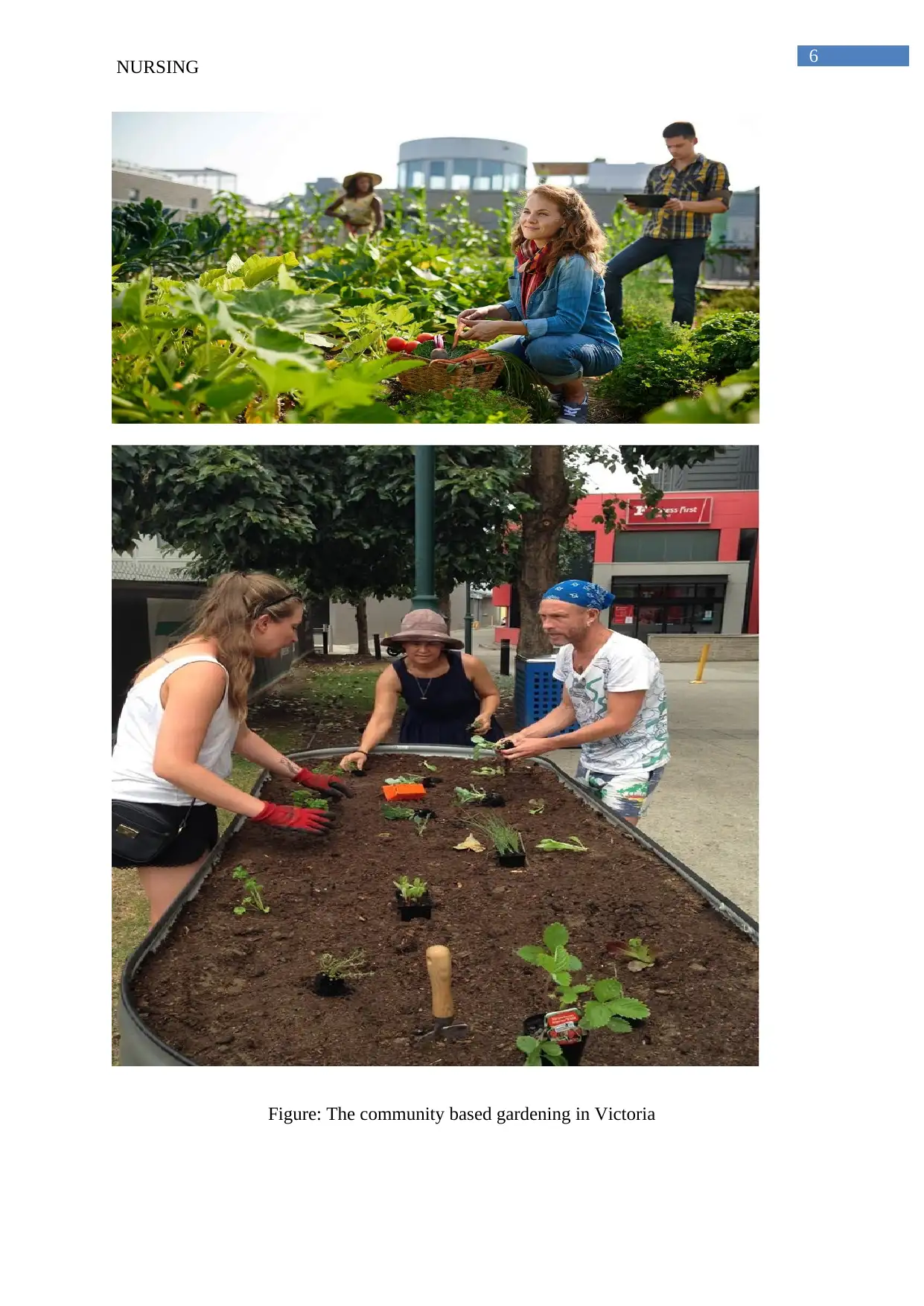
6
NURSING
Figure: The community based gardening in Victoria
NURSING
Figure: The community based gardening in Victoria
Paraphrase This Document
Need a fresh take? Get an instant paraphrase of this document with our AI Paraphraser
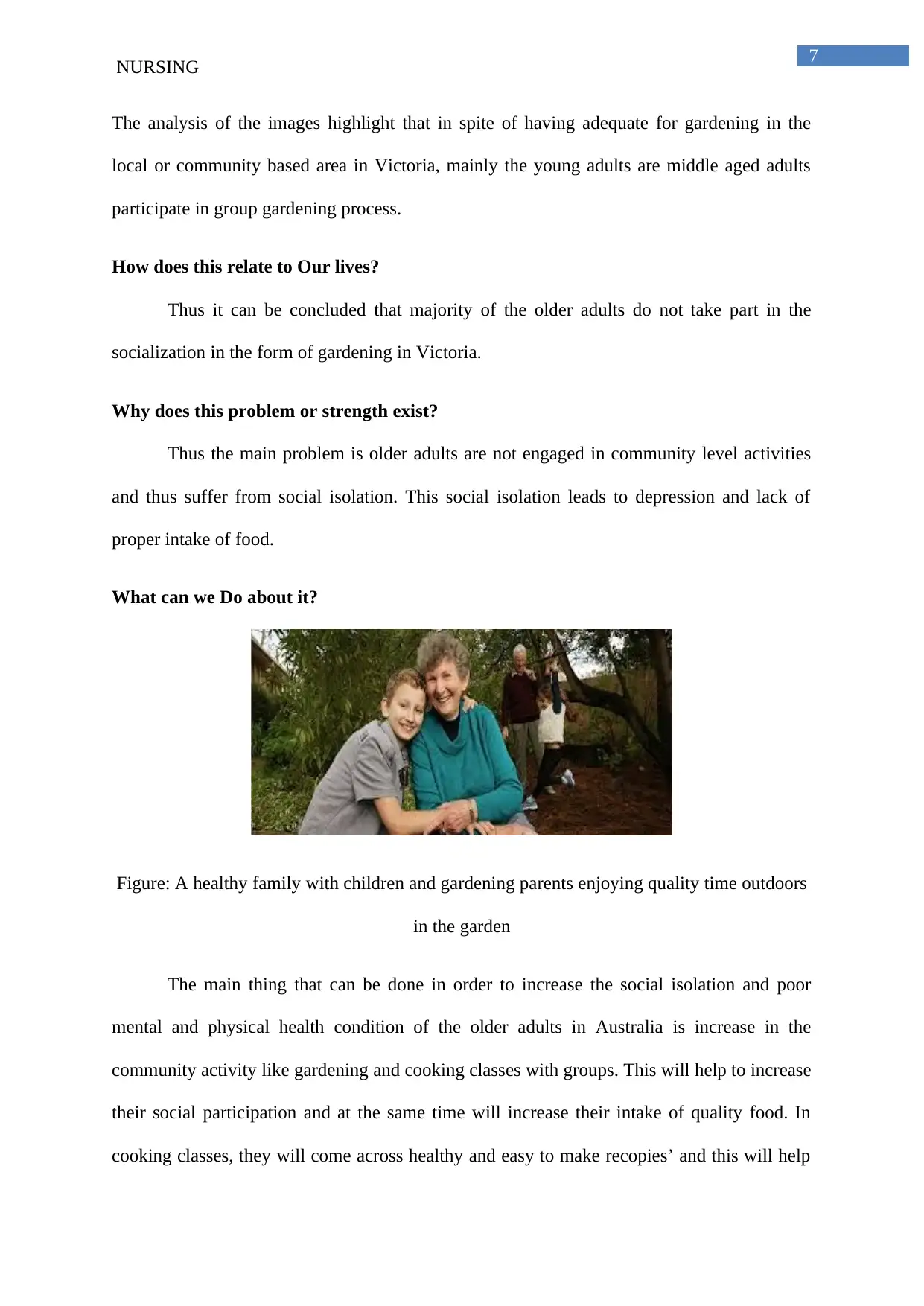
7
NURSING
The analysis of the images highlight that in spite of having adequate for gardening in the
local or community based area in Victoria, mainly the young adults are middle aged adults
participate in group gardening process.
How does this relate to Our lives?
Thus it can be concluded that majority of the older adults do not take part in the
socialization in the form of gardening in Victoria.
Why does this problem or strength exist?
Thus the main problem is older adults are not engaged in community level activities
and thus suffer from social isolation. This social isolation leads to depression and lack of
proper intake of food.
What can we Do about it?
Figure: A healthy family with children and gardening parents enjoying quality time outdoors
in the garden
The main thing that can be done in order to increase the social isolation and poor
mental and physical health condition of the older adults in Australia is increase in the
community activity like gardening and cooking classes with groups. This will help to increase
their social participation and at the same time will increase their intake of quality food. In
cooking classes, they will come across healthy and easy to make recopies’ and this will help
NURSING
The analysis of the images highlight that in spite of having adequate for gardening in the
local or community based area in Victoria, mainly the young adults are middle aged adults
participate in group gardening process.
How does this relate to Our lives?
Thus it can be concluded that majority of the older adults do not take part in the
socialization in the form of gardening in Victoria.
Why does this problem or strength exist?
Thus the main problem is older adults are not engaged in community level activities
and thus suffer from social isolation. This social isolation leads to depression and lack of
proper intake of food.
What can we Do about it?
Figure: A healthy family with children and gardening parents enjoying quality time outdoors
in the garden
The main thing that can be done in order to increase the social isolation and poor
mental and physical health condition of the older adults in Australia is increase in the
community activity like gardening and cooking classes with groups. This will help to increase
their social participation and at the same time will increase their intake of quality food. In
cooking classes, they will come across healthy and easy to make recopies’ and this will help
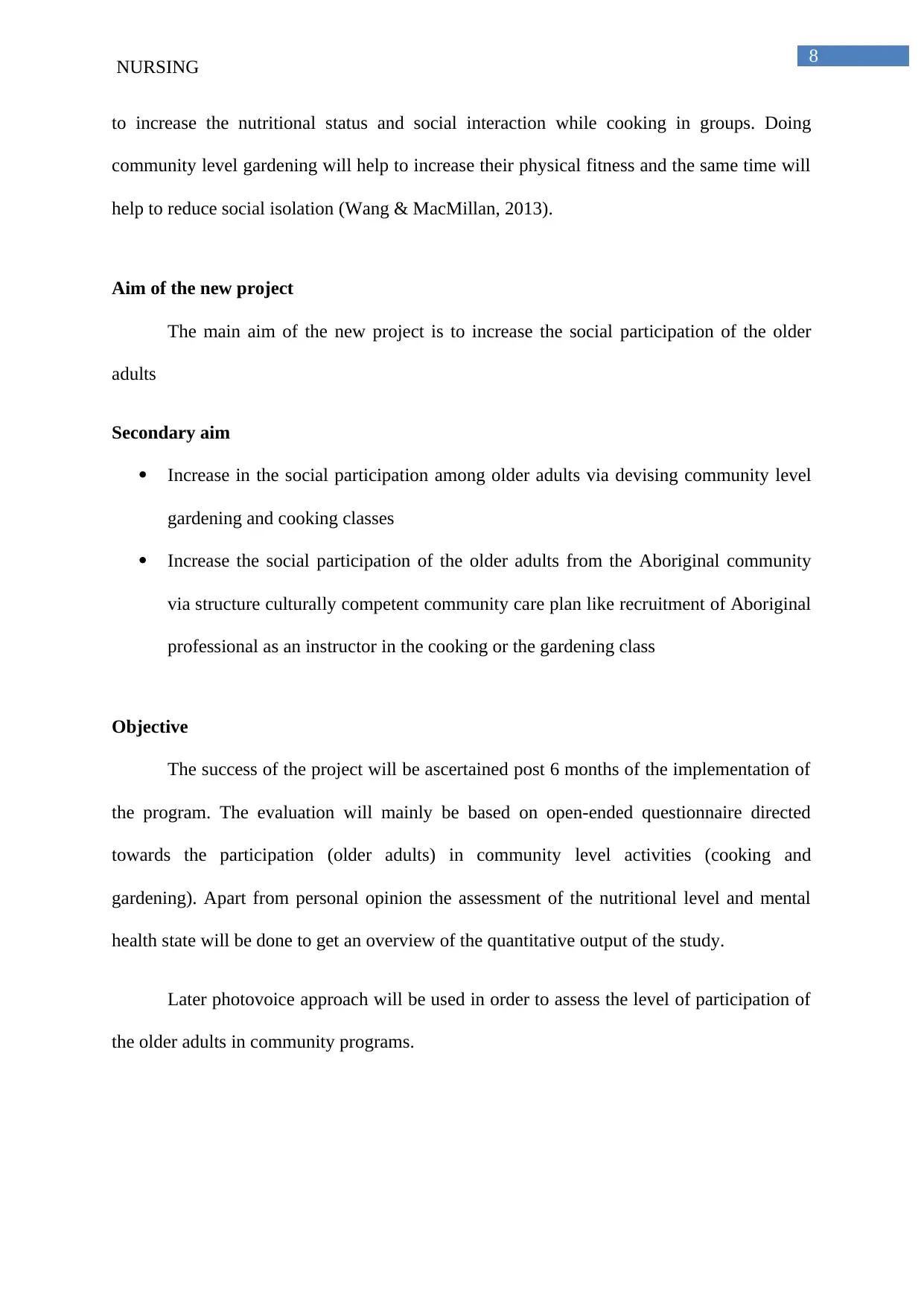
8
NURSING
to increase the nutritional status and social interaction while cooking in groups. Doing
community level gardening will help to increase their physical fitness and the same time will
help to reduce social isolation (Wang & MacMillan, 2013).
Aim of the new project
The main aim of the new project is to increase the social participation of the older
adults
Secondary aim
Increase in the social participation among older adults via devising community level
gardening and cooking classes
Increase the social participation of the older adults from the Aboriginal community
via structure culturally competent community care plan like recruitment of Aboriginal
professional as an instructor in the cooking or the gardening class
Objective
The success of the project will be ascertained post 6 months of the implementation of
the program. The evaluation will mainly be based on open-ended questionnaire directed
towards the participation (older adults) in community level activities (cooking and
gardening). Apart from personal opinion the assessment of the nutritional level and mental
health state will be done to get an overview of the quantitative output of the study.
Later photovoice approach will be used in order to assess the level of participation of
the older adults in community programs.
NURSING
to increase the nutritional status and social interaction while cooking in groups. Doing
community level gardening will help to increase their physical fitness and the same time will
help to reduce social isolation (Wang & MacMillan, 2013).
Aim of the new project
The main aim of the new project is to increase the social participation of the older
adults
Secondary aim
Increase in the social participation among older adults via devising community level
gardening and cooking classes
Increase the social participation of the older adults from the Aboriginal community
via structure culturally competent community care plan like recruitment of Aboriginal
professional as an instructor in the cooking or the gardening class
Objective
The success of the project will be ascertained post 6 months of the implementation of
the program. The evaluation will mainly be based on open-ended questionnaire directed
towards the participation (older adults) in community level activities (cooking and
gardening). Apart from personal opinion the assessment of the nutritional level and mental
health state will be done to get an overview of the quantitative output of the study.
Later photovoice approach will be used in order to assess the level of participation of
the older adults in community programs.
⊘ This is a preview!⊘
Do you want full access?
Subscribe today to unlock all pages.

Trusted by 1+ million students worldwide
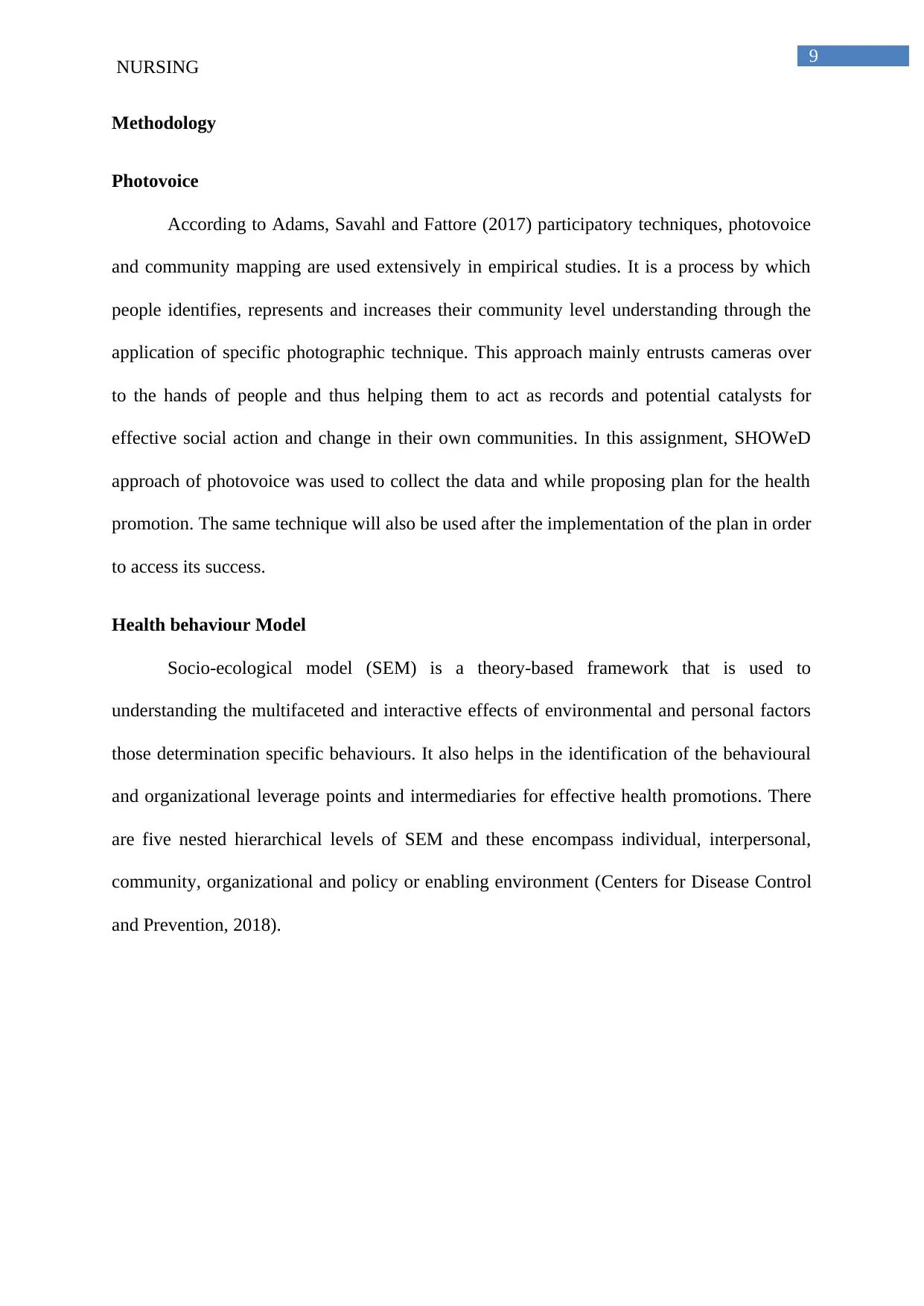
9
NURSING
Methodology
Photovoice
According to Adams, Savahl and Fattore (2017) participatory techniques, photovoice
and community mapping are used extensively in empirical studies. It is a process by which
people identifies, represents and increases their community level understanding through the
application of specific photographic technique. This approach mainly entrusts cameras over
to the hands of people and thus helping them to act as records and potential catalysts for
effective social action and change in their own communities. In this assignment, SHOWeD
approach of photovoice was used to collect the data and while proposing plan for the health
promotion. The same technique will also be used after the implementation of the plan in order
to access its success.
Health behaviour Model
Socio-ecological model (SEM) is a theory-based framework that is used to
understanding the multifaceted and interactive effects of environmental and personal factors
those determination specific behaviours. It also helps in the identification of the behavioural
and organizational leverage points and intermediaries for effective health promotions. There
are five nested hierarchical levels of SEM and these encompass individual, interpersonal,
community, organizational and policy or enabling environment (Centers for Disease Control
and Prevention, 2018).
NURSING
Methodology
Photovoice
According to Adams, Savahl and Fattore (2017) participatory techniques, photovoice
and community mapping are used extensively in empirical studies. It is a process by which
people identifies, represents and increases their community level understanding through the
application of specific photographic technique. This approach mainly entrusts cameras over
to the hands of people and thus helping them to act as records and potential catalysts for
effective social action and change in their own communities. In this assignment, SHOWeD
approach of photovoice was used to collect the data and while proposing plan for the health
promotion. The same technique will also be used after the implementation of the plan in order
to access its success.
Health behaviour Model
Socio-ecological model (SEM) is a theory-based framework that is used to
understanding the multifaceted and interactive effects of environmental and personal factors
those determination specific behaviours. It also helps in the identification of the behavioural
and organizational leverage points and intermediaries for effective health promotions. There
are five nested hierarchical levels of SEM and these encompass individual, interpersonal,
community, organizational and policy or enabling environment (Centers for Disease Control
and Prevention, 2018).
Paraphrase This Document
Need a fresh take? Get an instant paraphrase of this document with our AI Paraphraser
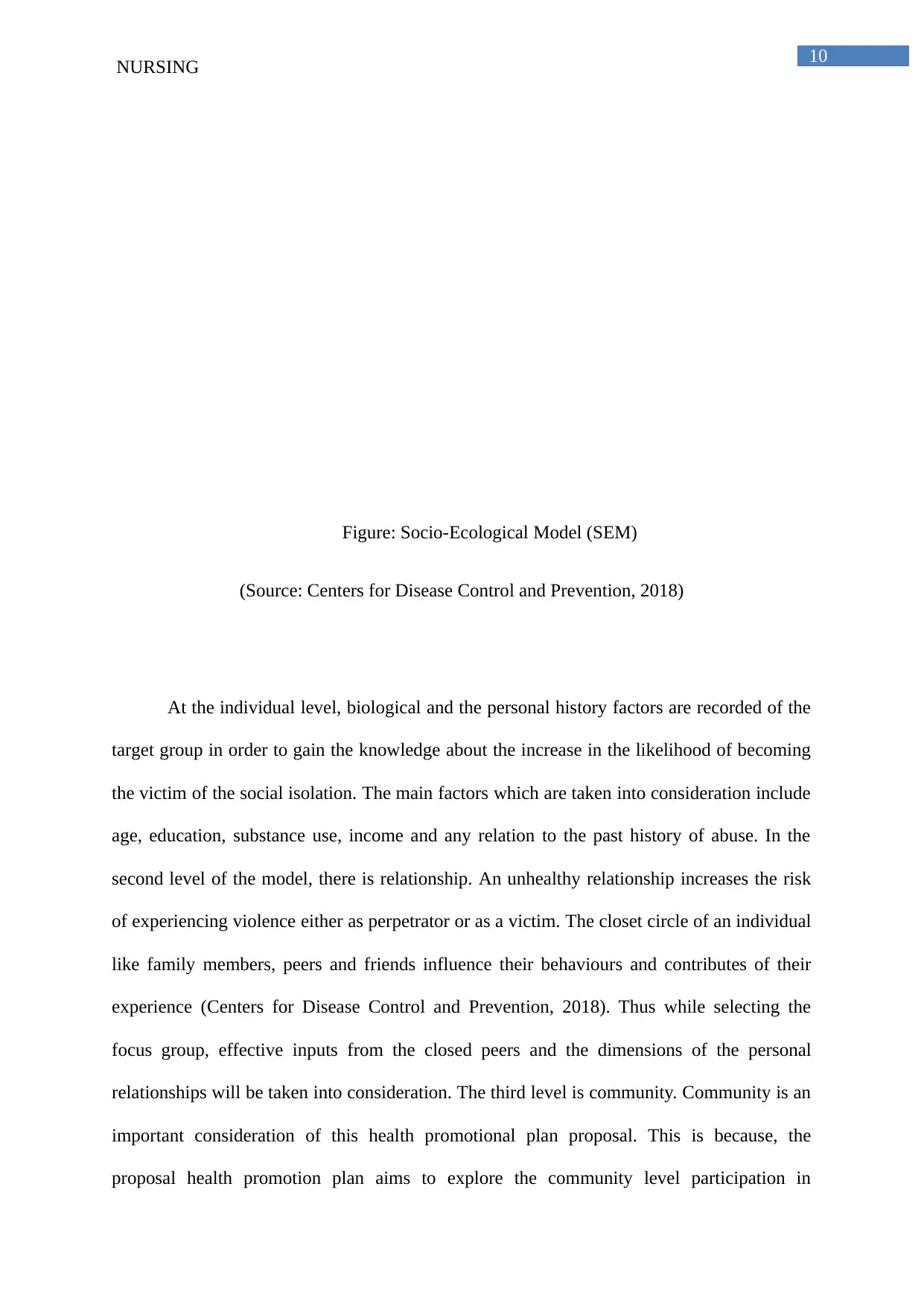
10
NURSING
Figure: Socio-Ecological Model (SEM)
(Source: Centers for Disease Control and Prevention, 2018)
At the individual level, biological and the personal history factors are recorded of the
target group in order to gain the knowledge about the increase in the likelihood of becoming
the victim of the social isolation. The main factors which are taken into consideration include
age, education, substance use, income and any relation to the past history of abuse. In the
second level of the model, there is relationship. An unhealthy relationship increases the risk
of experiencing violence either as perpetrator or as a victim. The closet circle of an individual
like family members, peers and friends influence their behaviours and contributes of their
experience (Centers for Disease Control and Prevention, 2018). Thus while selecting the
focus group, effective inputs from the closed peers and the dimensions of the personal
relationships will be taken into consideration. The third level is community. Community is an
important consideration of this health promotional plan proposal. This is because, the
proposal health promotion plan aims to explore the community level participation in
Policy/EnablingEnvironment(national,state,locallaws)Organizational(organizationsandsocialinstitutionsCommunity(relationshipsbetweenorganizations)Interpersonal(families,friends,socialnetworks)Individual(knowledge,attitudes,behaviors)
NURSING
Figure: Socio-Ecological Model (SEM)
(Source: Centers for Disease Control and Prevention, 2018)
At the individual level, biological and the personal history factors are recorded of the
target group in order to gain the knowledge about the increase in the likelihood of becoming
the victim of the social isolation. The main factors which are taken into consideration include
age, education, substance use, income and any relation to the past history of abuse. In the
second level of the model, there is relationship. An unhealthy relationship increases the risk
of experiencing violence either as perpetrator or as a victim. The closet circle of an individual
like family members, peers and friends influence their behaviours and contributes of their
experience (Centers for Disease Control and Prevention, 2018). Thus while selecting the
focus group, effective inputs from the closed peers and the dimensions of the personal
relationships will be taken into consideration. The third level is community. Community is an
important consideration of this health promotional plan proposal. This is because, the
proposal health promotion plan aims to explore the community level participation in
Policy/EnablingEnvironment(national,state,locallaws)Organizational(organizationsandsocialinstitutionsCommunity(relationshipsbetweenorganizations)Interpersonal(families,friends,socialnetworks)Individual(knowledge,attitudes,behaviors)
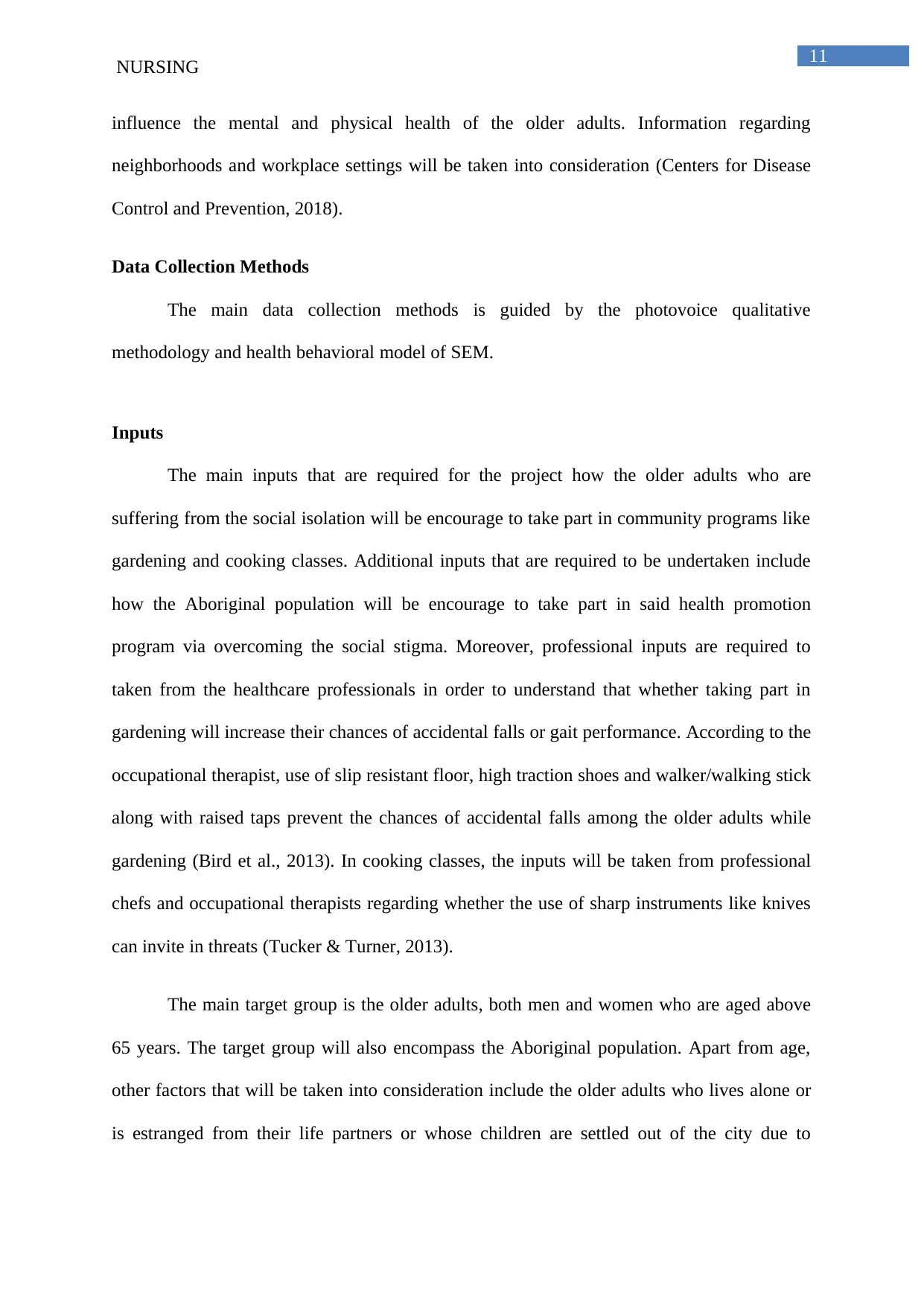
11
NURSING
influence the mental and physical health of the older adults. Information regarding
neighborhoods and workplace settings will be taken into consideration (Centers for Disease
Control and Prevention, 2018).
Data Collection Methods
The main data collection methods is guided by the photovoice qualitative
methodology and health behavioral model of SEM.
Inputs
The main inputs that are required for the project how the older adults who are
suffering from the social isolation will be encourage to take part in community programs like
gardening and cooking classes. Additional inputs that are required to be undertaken include
how the Aboriginal population will be encourage to take part in said health promotion
program via overcoming the social stigma. Moreover, professional inputs are required to
taken from the healthcare professionals in order to understand that whether taking part in
gardening will increase their chances of accidental falls or gait performance. According to the
occupational therapist, use of slip resistant floor, high traction shoes and walker/walking stick
along with raised taps prevent the chances of accidental falls among the older adults while
gardening (Bird et al., 2013). In cooking classes, the inputs will be taken from professional
chefs and occupational therapists regarding whether the use of sharp instruments like knives
can invite in threats (Tucker & Turner, 2013).
The main target group is the older adults, both men and women who are aged above
65 years. The target group will also encompass the Aboriginal population. Apart from age,
other factors that will be taken into consideration include the older adults who lives alone or
is estranged from their life partners or whose children are settled out of the city due to
NURSING
influence the mental and physical health of the older adults. Information regarding
neighborhoods and workplace settings will be taken into consideration (Centers for Disease
Control and Prevention, 2018).
Data Collection Methods
The main data collection methods is guided by the photovoice qualitative
methodology and health behavioral model of SEM.
Inputs
The main inputs that are required for the project how the older adults who are
suffering from the social isolation will be encourage to take part in community programs like
gardening and cooking classes. Additional inputs that are required to be undertaken include
how the Aboriginal population will be encourage to take part in said health promotion
program via overcoming the social stigma. Moreover, professional inputs are required to
taken from the healthcare professionals in order to understand that whether taking part in
gardening will increase their chances of accidental falls or gait performance. According to the
occupational therapist, use of slip resistant floor, high traction shoes and walker/walking stick
along with raised taps prevent the chances of accidental falls among the older adults while
gardening (Bird et al., 2013). In cooking classes, the inputs will be taken from professional
chefs and occupational therapists regarding whether the use of sharp instruments like knives
can invite in threats (Tucker & Turner, 2013).
The main target group is the older adults, both men and women who are aged above
65 years. The target group will also encompass the Aboriginal population. Apart from age,
other factors that will be taken into consideration include the older adults who lives alone or
is estranged from their life partners or whose children are settled out of the city due to
⊘ This is a preview!⊘
Do you want full access?
Subscribe today to unlock all pages.

Trusted by 1+ million students worldwide
1 out of 18
Related Documents
Your All-in-One AI-Powered Toolkit for Academic Success.
+13062052269
info@desklib.com
Available 24*7 on WhatsApp / Email
![[object Object]](/_next/static/media/star-bottom.7253800d.svg)
Unlock your academic potential
Copyright © 2020–2025 A2Z Services. All Rights Reserved. Developed and managed by ZUCOL.





